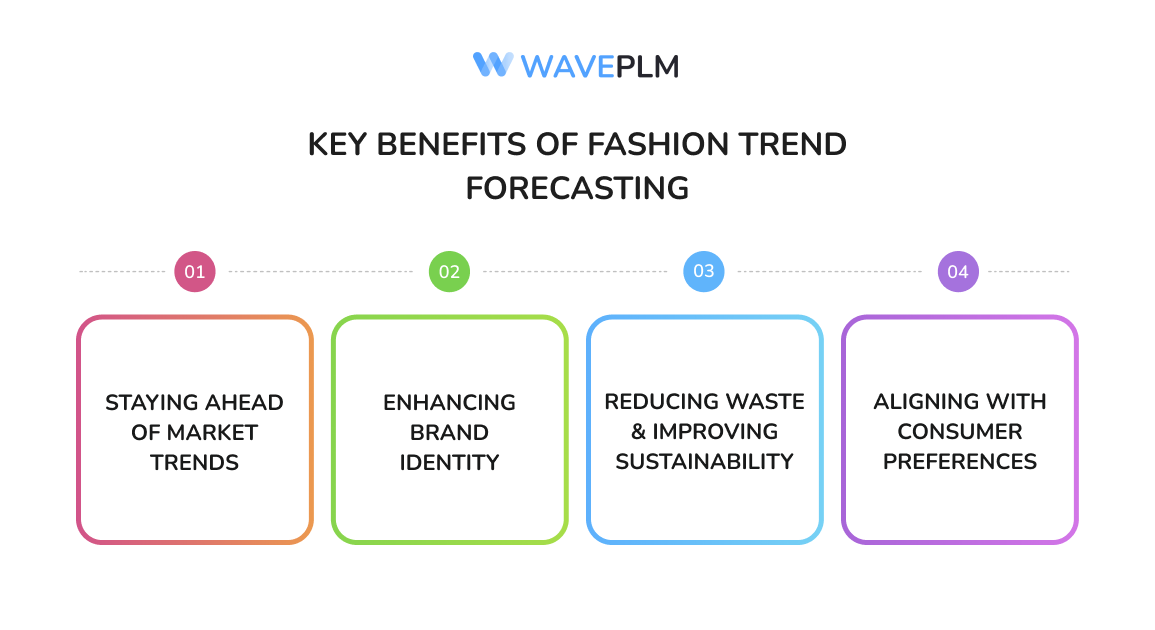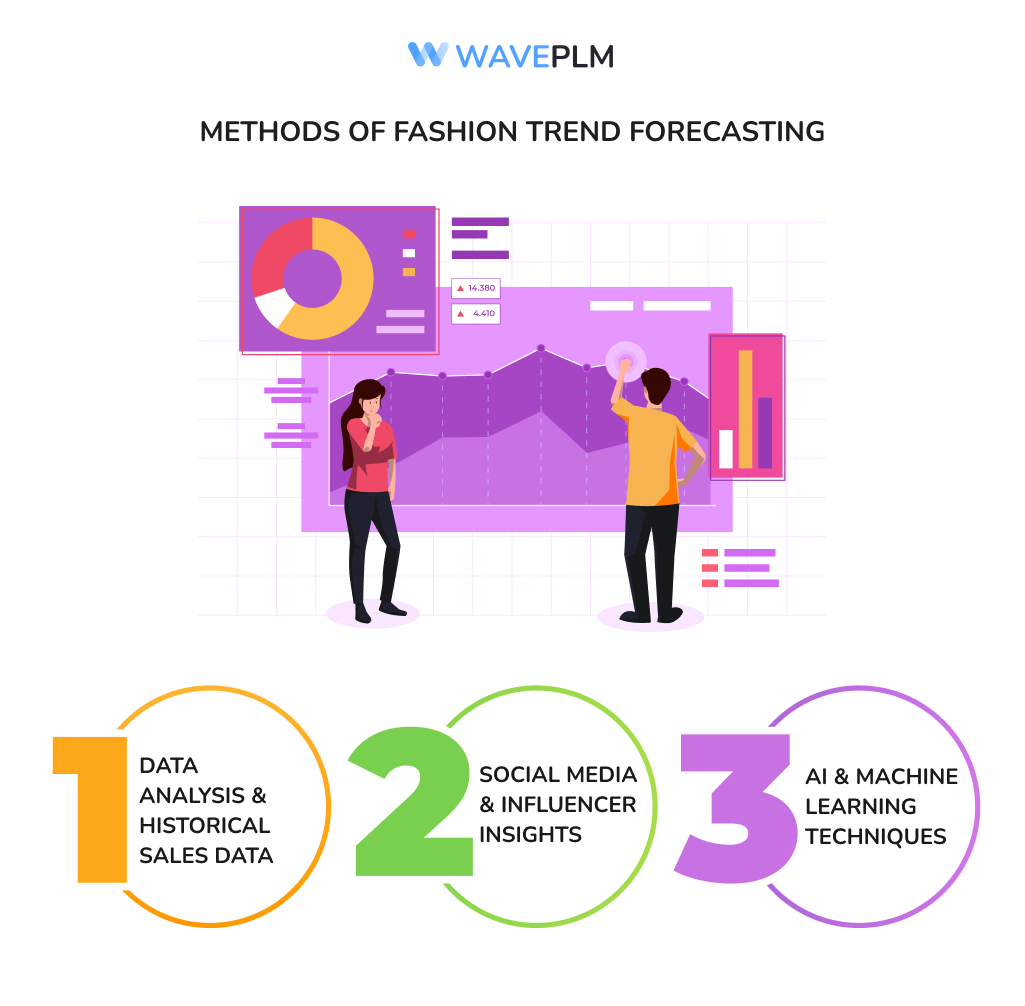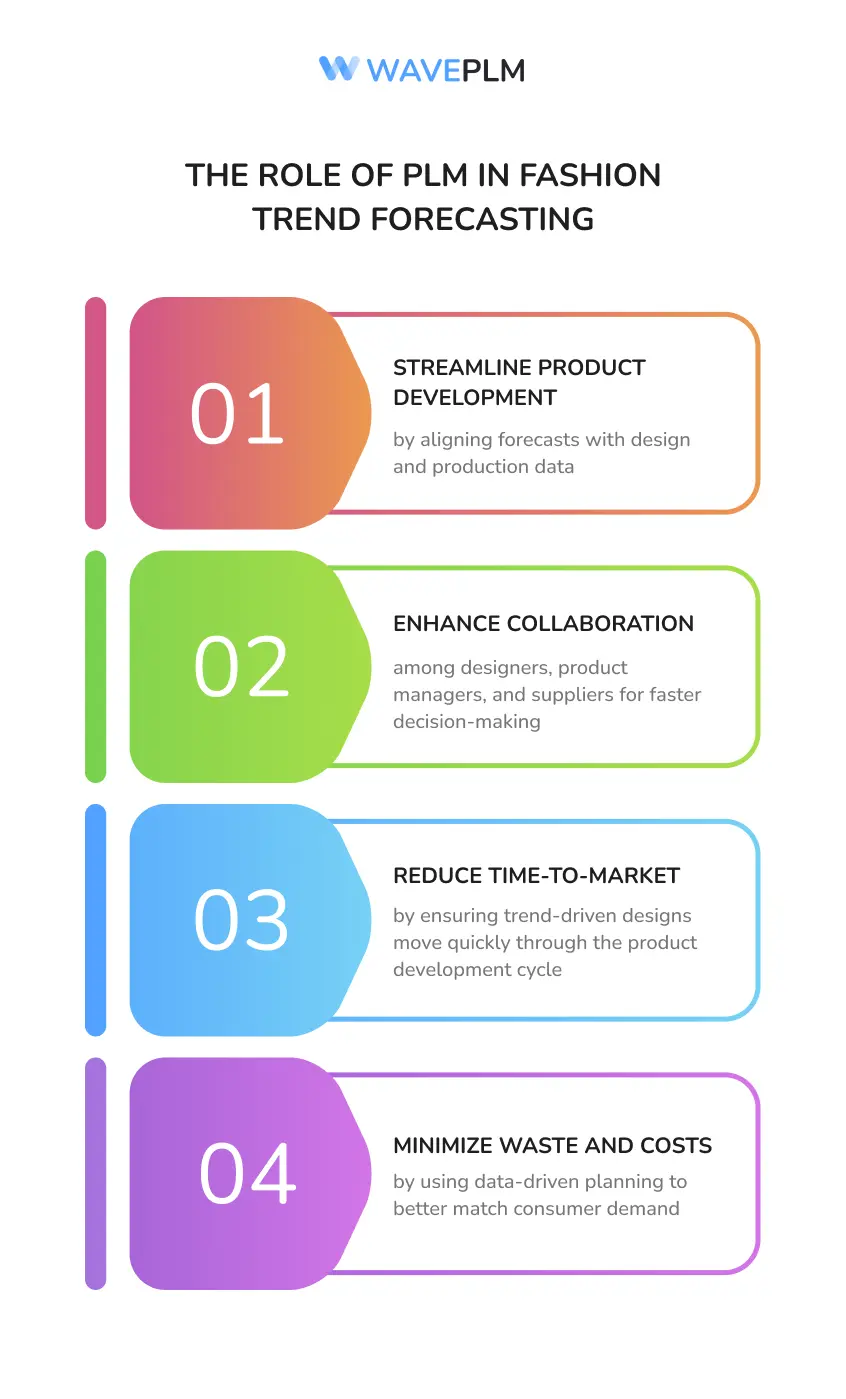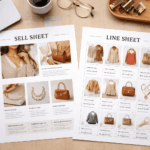
Forecasting in the fashion industry is essential for predicting future trends and staying competitive. By understanding market changes and consumer preferences, brands can create desirable collections ahead of time. This article covers the best practices and upcoming trends in fashion forecasting.
Key Takeaways
- Fashion trend forecasting is essential for brands to align their product offerings with market demands and consumer preferences, utilizing both short-term and long-term insights.
- Key benefits of trend forecasting include staying ahead of market trends, enhancing brand identity, reducing waste, and improving sustainability practices within the fashion industry.
- Technological advancements, including AI and data analysis, are transforming trend forecasting, enabling brands to make more accurate predictions and adapt effectively to global market dynamics.
Understanding Fashion Trend Forecasting
Fashion trend forecasting involves predicting future trends in fashion through research, analysis, and creativity. The primary goal is to ensure that the production of desirable styles aligns with market needs, helping brands innovate within trends or inspire new ones. This practice is crucial for fashion businesses as it allows them to prepare products ahead of trends, thereby protecting sales and their brand image.
The influence of fashion forecasting extends to designers, manufacturers, and retailers within the fashion industry, affecting their decisions significantly. In trend forecasting, there are two main types: short-term forecasting, which focuses on immediate trends, and long-term forecasting, which looks at trends over a two-year horizon. This dual approach ensures that brands can stay relevant in both the immediate and distant future.
Trend forecasters analyze data from various elements including:
- Trends in colors
- Fabrics
- Styles
- Silhouettes They also assess:
- Consumer interests
- Market shifts
- Economic changes Factors such as cultural, social, and political influences, along with global issues, play a significant role in shaping fashion trends.
Understanding these trends helps consumers anticipate upcoming popular styles and what might be in demand in the near future, making fashion forecasting a critical tool for both brands and consumers alike. Attending fashion shows, analyzing social media, and studying historical sales data allow trend forecasters to predict trends with remarkable accuracy.
Staying ahead in the fashion world requires more than just creativity; it demands a strategic approach to trend forecasting. This involves a deep understanding of current market trends, consumer behavior, and the ability to predict future trends. As we delve deeper, we will explore the numerous benefits of fashion trend forecasting and the methods used to achieve precise and actionable insights.
Key Benefits of Fashion Trend Forecasting
Fashion trend forecasting provides a competitive edge, allowing brands to anticipate upcoming trends, enhance their identity, reduce waste, and align with consumer preferences. These benefits are crucial for maintaining market relevance and driving sales.
Here are the detailed advantages.
Staying Ahead of Market Trends
Trend forecasting offers valuable insights into consumer preferences regarding colors, patterns, and fabrics, enabling brands to create collections that resonate with customers before trends go mainstream. Predicting trends proactively helps brands stay ahead of their competitors and align their collections with market demands. This proactive approach is particularly beneficial in the fast fashion industry, where rapid turnaround and market responsiveness are crucial, as seen in the latest colour forecasts and colour palettes. Trend prediction plays a key role in this process.
Competitor analysis during trend forecasting helps identify emerging trends and capitalize on them before rivals do. This involves analyzing various external factors, including cultural and political influences, to understand and predict fashion trends effectively. Significant events in art, sports, science, and technology can also influence short-term trends, making them essential for forecasting.
Global research conducted by platforms like WGSN helps fashion brands understand emerging trends and guide their design and production strategies. This comprehensive approach ensures that brands can stay competitive and cater to ever-changing consumer preferences.
Enhancing Brand Identity
Aligning trends with a brand’s fundamental aesthetics can significantly strengthen its identity. Trend analysis aids companies in maintaining a cohesive image while adapting to evolving consumer tastes.
Fashion brands that effectively utilize trend forecasting often see a significant boost in their market relevance and consumer engagement. This is particularly true for a fashion brand that embraces innovative strategies.
Reducing Waste and Improving Sustainability
Fashion trend forecasting can lead to significant reductions in overproduction and raw materials waste. By predicting which items are likely to succeed in the market, fashion forecaster brands can enhance their sustainable practices.
As consumer awareness about environmental impacts increases, the integration of sustainability and ethical practices is becoming crucial in future fashion forecasting.
Aligning with Consumer Preferences
Trend forecasting involves:
- Analyzing the impact of consumer behaviors, market structures, and customer values on future trends.
- Informing brands about preferred materials and colors among consumers.
- Helping brands understand current consumer sentiments through sentiment analysis of social media discussions, while also forecasting trends.
Meltwater leverages AI technology to analyze real-time social media data, allowing brands to gauge consumer sentiment. Several fashion brands, including luxury fashion houses, leverage trend forecasting to drive their collections, ensuring they align with consumer preferences and cultural movements.
Global interconnectedness is leading to a blending of fashion styles and cultural influences, impacting trend forecasting significantly.

Methods of Fashion Trend Forecasting
Fashion trend forecasting employs various methods, including data analysis, social media insights, and AI techniques, to predict upcoming trends accurately. These methods provide a comprehensive view of the fashion landscape and enable brands to make informed decisions.
Let’s explore these methods in detail.
Data Analysis and Historical Sales Data
Forecasting models rely on both quantitative and qualitative historical data to predict future sales. Luxury brands often focus on enduring styles and macro-trends, utilizing past sales data to inform future collections. WGSN combines trend forecasting with data science to provide insights that help businesses predict consumer behavior. Utilizing advanced forecasting tools can significantly improve the precision of trend predictions.
Technological advancements, such as AI and data analytics, are transforming how fashion trends are predicted and tracked. Forecasting enables brands to identify essential pieces for their collections that capture public attention. Analyzing historical sales data helps brands make informed decisions about future collections and marketing strategies.
Social Media and Influencer Insights
Staying alert to social media and cultural signals can provide early insights into shifts in consumer demand. Influencers, including social media fashion bloggers, play a key role in shaping consumer behaviour and perceptions in fashion through their online presence. The platform can track the popularity of styles in real-time by examining engagement metrics on visual content.
Understanding consumer insights allows brands to refine their offerings and better meet market demands. Analyzing social media activities enables brands to stay ahead of emerging trends and align their collections with current consumer preferences through market research.
AI and Machine Learning Techniques
Machine learning in fashion forecasting can help identify emerging trends by processing and analyzing vast amounts of consumer data. Fashion forecasting is expected to integrate artificial intelligence for more accurate trend predictions.
This integration will enhance the efficiency and precision of trend forecasting, making it a valuable tool for fashion brands and trend union.

Tools and Platforms for Fashion Trend Forecasting
Tools and platforms play a crucial role in aiding fashion brands to predict trends accurately and remain competitive in the fast-paced industry. Key platforms like WGSN, Meltwater, and Heuritech offer comprehensive services that help brands stay ahead of market trends.
Let’s explore each of these tools in detail.
WGSN and Its Services
WGSN is a subscription service for fashion brands that provides insights on trends. WGSN offers global research on fabrics, designs, and consultancy services to assist with collections. Trend forecasting helps businesses align their products with consumer expectations, thereby enhancing their market position.
Utilizing WGSN’s services helps fashion brands stay ahead of upcoming trends and make informed decisions about their collections. This comprehensive approach ensures that brands can cater to evolving consumer preferences and maintain their competitive edge in the market.
Meltwater’s Real-Time Data Analysis
Meltwater analyzes billions of data points in real-time from various sources:
- Social media
- Websites
- Blogs
- Podcasts
Meltwater leverages AI technology to process vast amounts of social media data, enabling rapid trend identification. The platform provides quick insights and identifies related hashtags, assisting in fashion trend forecasting.
The analysis of consumer conversations helps in creating desired fashions and effective marketing. Fashion consumer insights are generated by analyzing social media conversations and keywords. Businesses can set up mentions and keywords related to their target audience to gain personalized insight. This personalized approach ensures that brands can align their offerings with current market demands.
Heuritech’s Image Recognition Technology
Heuritech utilizes visual analysis to identify fashion trends by analyzing images from social media. Heuritech uses advanced image recognition to analyze visual content, identifying trends based on what is visually trending.
The technology helps brands anticipate changes in consumer preferences by analyzing the popularity of styles in images.
Implementing Trend Forecasting in Your Fashion Business
Implementing trend forecasting and demand forecasting in a fashion business is essential for adapting to market changes and consumer preferences. This involves integrating forecasting tools, collaborating with forecasters, and staying adaptable to market dynamics.
Let’s explore how to effectively implement trend forecasting in your fashion business.
Integrating Forecasting Tools
Trend forecasters provide valuable insights that can benefit businesses and designers by trend forecasts and trend reports:
- Helping in planning upcoming collections
- Assisting in making merchandising decisions
- Enabling brands to design products that meet current demands and anticipate future consumer interests
- Offering predictive analytics to assist brands in making timely product launches and marketing strategies
Fast fashion companies leverage trend forecasting to rapidly produce collections that match fleeting trends, enabling quick turnaround and high sales volume. Integrating forecasting tools ensures that brands remain responsive to market dynamics and consumer preferences.
Collaborating with Trend Forecasters
Trend forecasters provide:
- Creative and operational support to designers, allowing for informed design decisions.
- Collaboration with data analysts and designers, which is essential for successful integration of forecasting tools.
- Enhanced design processes and alignment of product offerings with market demands through collaboration with professional trend forecasters.
The benefits of working with professional trend forecasters include improved trend alignment, enhanced creativity, and operational efficiencies in the design process. This collaborative approach ensures that brands can stay competitive and relevant in the fashion industry.
Adapting to Market Changes
Staying adaptable to market fluctuations is essential for retailers to maintain competitiveness in the fashion industry. Continuously monitoring market trends and consumer preferences allows brands to adjust their target market purchasing decisions and offerings to stay relevant.
This adaptability is crucial for long-term success in the constantly evolving fashion business.
Case Studies of Successful Trend Forecasting
Examining real-world examples of successful trend forecasting provides valuable insights into its practical applications and benefits.
Let’s explore case studies from high-fashion brands and fast fashion retailers to understand how they effectively utilize trend forecasting.
High-Fashion Brands
Luxury brands often leverage trend forecasting to align their collections with customer expectations, maintaining their competitive edge in the market. These brands utilize trend forecasting to not only anticipate consumer desires but also to ensure exclusivity and maintain brand prestige.
By staying ahead of market changes, luxury brands can innovate their product lines effectively.
Fast Fashion Retailers
Trend forecasting is crucial for fast fashion companies, allowing them to stay aligned with the latest consumer preferences and emerging trends. These companies utilize trend forecasting to quickly adapt their inventory according to the latest consumer preferences and emerging fashion trends. By capitalizing on micro-trends, fast fashion brands can rapidly produce items to meet fleeting consumer demand.
Brands like Zara and H&M exemplify effective trend forecasting by rapidly producing new collections that respond to real-time consumer preferences. This approach enables them to maintain high sales volumes and market relevance, demonstrating the power of precise trend forecasting in the fast fashion industry.
Future Trends in Fashion Forecasting
As we look to the upcoming seasons, technological advancements and globalization are set to transform fashion forecasting and fad forecasting. These changes will enable more accurate predictions and a deeper understanding of global market dynamics, including long term forecasts.
Let’s explore these future trends in detail.
Increasing Role of Technology
Advancements in fashion forecasting play an increasingly important role in shaping the fashion industry. These advancements enable fashion brands to stay relevant and competitive in a rapidly changing market. Generative AI is projected to significantly enhance operational efficiency in fashion, potentially increasing industry profits by up to $275 billion within a few years.
Embracing technological advancements is crucial for fashion brands to effectively adapt to future trends and consumer demands. Leveraging AI and other new technologies enables brands to achieve more accurate and efficient trend forecasting, ensuring their long-term success in the fashion industry.
Globalization and Cultural Influences
Globalization is leading to a fusion of cultural different styles, significantly impacting fashion trends and pop culture forecasting. As diverse cultural backgrounds merge, the latest styles in fashion trends and new styles are influenced by a broader range of fashion moves and preferences.
This cultural fusion necessitates a flexible approach to trend forecasting in the fashion industry. Staying attuned to these global influences allows brands to better predict and adapt to future trends.
Summary
Fashion trend forecasting is an indispensable tool for brands aiming to stay competitive and innovative in the ever-evolving fashion industry. By understanding and predicting future trends, brands can create collections that resonate with consumers, enhance their identity, reduce waste, and adapt to market changes. Embracing technological advancements and global cultural influences will further enhance the accuracy and efficiency of trend forecasting, ensuring long-term success for fashion businesses.
The Role of PLM in Fashion Trend Forecasting
Product Lifecycle Management (PLM) systems play a vital role in supporting effective fashion trend forecasting. PLM integrates product data, design processes, and production workflows, giving brands a centralized platform to manage their collections from concept to consumer.
By combining trend forecasting insights with PLM tools, fashion businesses can:
- Streamline product development by aligning forecasts with design and production data
- Enhance collaboration among designers, product managers, and suppliers for faster decision-making
- Reduce time-to-market by ensuring trend-driven designs move quickly through the product development cycle
- Minimize waste and costs by using data-driven planning to better match consumer demand
PLM systems also help capture valuable historical data, which can feed into future trend forecasting models and support continuous improvement. As the fashion industry embraces AI, sustainability, and global market dynamics, integrating PLM with forecasting processes will become even more critical to staying competitive and agile.

Frequently Asked Questions
What is fashion trend forecasting?
Fashion trend forecasting is the process of predicting future fashion trends through research and analysis, ensuring that production meets market needs effectively. This strategic foresight is essential for staying relevant in the dynamic fashion industry.
How does trend forecasting benefit fashion brands?
Trend forecasting enables fashion brands to remain competitive, refine their identity, and align with consumer preferences, ultimately enhancing market relevance and boosting sales.
What methods are used in fashion trend forecasting?
Fashion trend forecasting utilizes data analysis, social media insights, and AI techniques to make precise predictions about future trends. These methods allow industry professionals to stay ahead of the curve in the rapidly changing fashion landscape.
What are some key tools for fashion trend forecasting?
To stay ahead in fashion trend forecasting, utilizing tools like WGSN, Meltwater, and Heuritech is essential for gaining insights and market intelligence. These resources provide comprehensive services that can help you effectively navigate trends.
How can fashion businesses implement trend forecasting?
Fashion businesses can effectively implement trend forecasting by utilizing forecasting tools, working with professional trend forecasters, and remaining adaptable to market changes. This strategic approach will enhance their ability to stay aligned with consumer demands and industry shifts.




